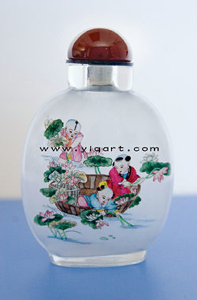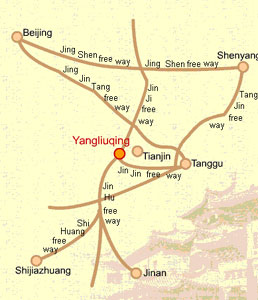Yangliuqing painting turns young
Updated:2011-11-03 11:57
By Gao Qihui and Quan Li (chinadaily.com.cn)
|
|
|
Editor's note: |
|
|
What is Yangliuqing nianhua? Yangliuqing nianhua (New Year painting) is a kind of folk woodcut, named after its production place - Yangliuqing town of Tianjin. The traditional works are made mainly through a combination of woodblock carving and hand painting. A heritage worthy of protection Ingenious and unique in composition, fresh and smooth in line, vivid and life-like in form, and strong and rich in essence, Yangliuqing nianhua generally feature ancient beauties, lovely children, folk customs or stories from classical operas, myths and legends. [More] The traditional nianhua actually has multiple functions, There are ancient woodblocks called bi huo tu (fire-proof pictures) that have vivid love scenes, accompanied by explicit instructions. They were presented as a gift by parents to a newly married daughter as a kind of guide. [More]
|
|
| |
|
Making a Yangliuqing New Year painting generally requires at least 20 painstaking steps, ranging from sketching, engraving, printing and hand painting to mounting. Each picture is an independent creation. Maintaining the sincerity of traditional folk paintings,Yangliuqing pictures absorbed the characteristics of traditional Chinese "realistic" paintings and paid close attention to details of the figures. Unlike some artists, artisans of Yangliuqing nianhua must stand erect during the process and paint on "door planks". The following vedio shows three main steps of making Yangliuqing nianhua. | |
|
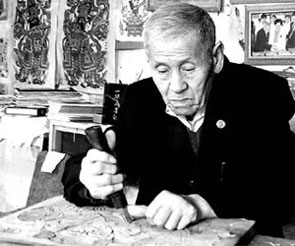 Engraving |
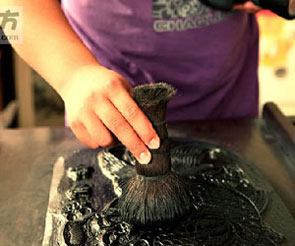 Printing |
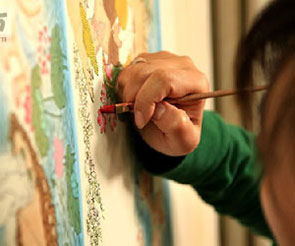 Painting |
|
|
|
The woodblock New Year paintings are said to have first appeared during the Tang Dynasty (AD 618-907). However, since the art form was not a high-class cultural icon, it was not well-documented in history books of the time. Yangliuqing nianhua enjoyed its heyday in the Ming (1368-1644) and early Qing (1644-1911) dynasties. In the reign of Emperor Qianlong in the Qing Dynasty, of the 30 villages in Yangliuqing township, there were over 300 art studios with at least 3,000 folk artisans engaged in nianhua production, local records show. And on the three main streets of the township proper, there were hundreds of art shops, selling nianhua and other folk art works in at least 2,000 varieties, catering to the demands from consumers in North and Northeast China provinces. Over the years the traditional folk art has been on the verge of extinction. The paintings were rejected as a form of superstition after the founding of New China in 1949, but in the countryside villagers still bought them to decorate their homes. "It was in the past two decades with the fast pace of globalization and economic growth that the art began disappearing at a record rate, falling nearly into extinction," says Huo Qingyou, a master nianhua artist in Yangliuqing. To widen profit margins, new techniques such as serigraphs and offset lithography are used to enhance the output of some nianhua studios.[More] |
|
|
|
Big policy's back | |
|
Culture in the spotlight |
CPC turns to culture to sustain nation's rise |
|
Yangliuqing press set up
|
|
The Tianjin Yangliuqing Fine Arts Press was named by the municipal government as a time-honored brand in 2007. It was promoted to be a symbolic brand of Tianjin. Tianjin Yangliuqing Fine Arts Press has collected an unrivaled volume of 6,500 ancient wooden blocks for making New Year pictures, with the oldest from the Ming Dynasty. The press has explored new forms to promote Yangliuqing nianhua by painting the nianhua on the inside of traditional Chinese snuff bottles, handcrafted folding fans, quills, Jingdezhen porcelain and paper cutouts, which have received market recognition. It also included the Yangliuqing-painted cell phone accessories and metal bookmarks. It has developed more than 200 new products with a Yangliuqing nianhua theme. Now, the press sells more than 20,000 snuff bottles with the Yangliuqing New Year painting inside per year. With the help of the municipal government, the press set up a center for Yangliuqing nianhua in 2010 to further promote the Yangliuqing culture. The center includes a museum and an education center.
With thousands of years of culture and legacy, Yangliuqing town used to bloom with various folk arts and crafts, including Yangliuqing painting of the Lunar New Year, kites, paper cutting, brick and stone sculptures. At the town, some stores sell the paintings to just a few customers, showing that tradition is not essential for modern life. The golden age of Yangliuqing has gone, only the paintings depicting those glorious times still shine as it was. The town is easily accessible. It lies to the west of Tianjin, about 15 kilometers away from the city. Since 2009, Tianjin has invested 4 billion yuan ($630 million) to boost tourism in the town.[More] |
Slide:Yangniuqing Nianhua paintings




